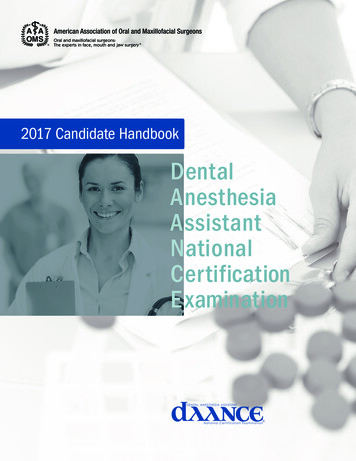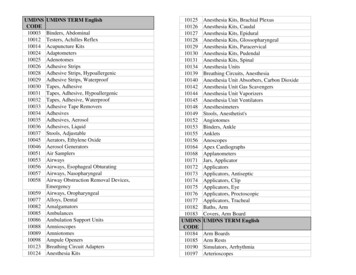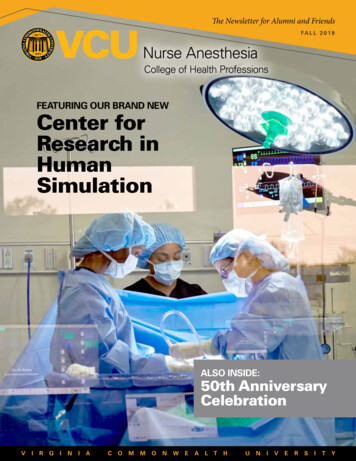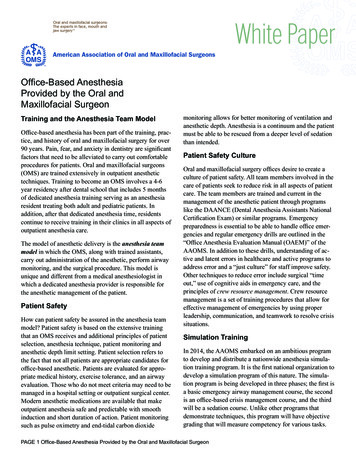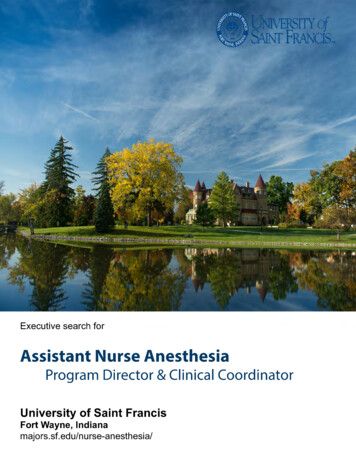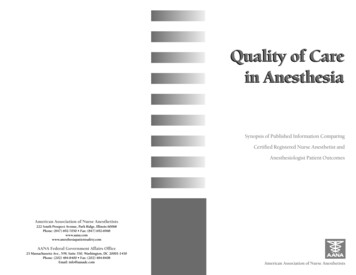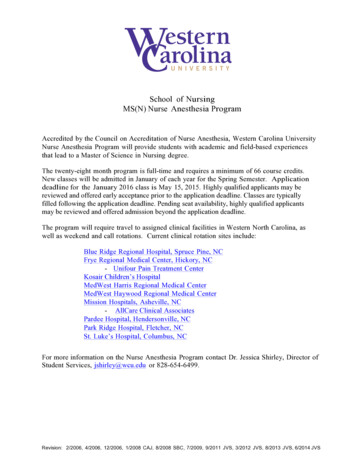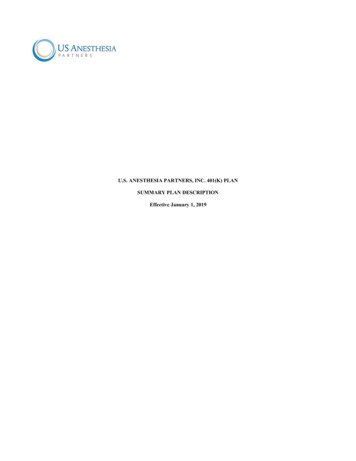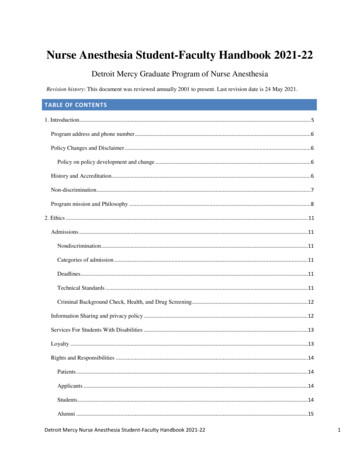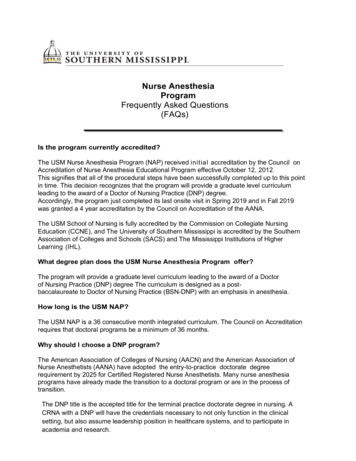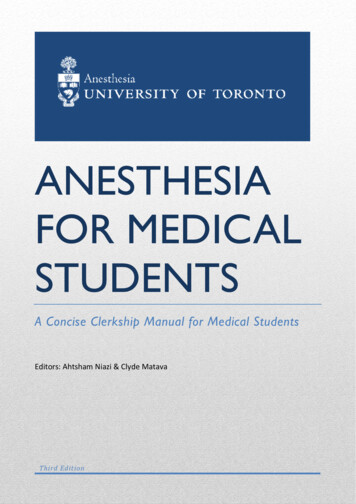
Transcription
ANESTHESIAFOR MEDICALSTUDENTSA Concise Clerkship Manual for Medical StudentsEditors: Ahtsham Niazi & Clyde MatavaThird Edition
Anesthesia for Medical Students1Table of ContentsCONTRIBUTORS .6COURSE OBJECTIVES.8Goals .8General Competencies .8Medical Expert/Skilled Clinical Decision Maker .8Communicator/Doctor-Patient Relationship .8Collaborator .8Leader .9Health Advocate/Community Resources .9Scholar.9Professional .9Educational Core Objectives .9Skills. 10Problem-based encounters . 10Textbooks/Learning Resources . 11DETAILED OBJECTIVES AND STUDY GUIDE. 12Medical Expert (Revised June 2016) . 12Airway Management . 12Pharmacology . 13Resuscitation . 13Regional Anesthesia . 13Obstetrical Anesthesia . 14Pediatric Anesthesia . 14Acute Pain Management . 14Post-Operative Management . 14Patient Safety (see professional section for more details) . 14Skills. 14Communicator . 15MCC Objectives. 15Collaborator . 15MCC Objectives. 15Leader . 16MCC Objectives. 16Health Advocate. 16MCC Objectives. 16Scholar. 16MCC Objectives. 16
Anesthesia for Medical Students2Professional . 16MCC Objectives. 17INTRAVENOUS LINE INSERTION GUIDELINES . 18PREOPERATIVE ASSESSMENT . 19Preoperative Assessment of the Patient with Cardiac Disease . 20Introduction . 20Evaluation of comorbid conditions . 20Conclusion . 23Preoperative Assessment of the Patient with Respiratory Disease . 24Asthma . 24Postoperative pulmonary complications . 32Anesthetic Risk: Morbidity and Mortality . 35Anesthesia-Related Mortality . 35Anesthesia-Related Morbidity . 36Perioperative Complications that are Modifiable by Anesthesia Management . 37Summary . 38AIRWAY MANAGEMENT. 42AirwayManagement . 43Airway Anatomy . 43Evaluation of the Airway . 46Pre-oxygenation13. 48Direct Laryngoscopy (DL). 48Supraglottic Airways (SGA) . 53Flexible Bronchoscopic Intubation19-21. 54Indirect Laryngoscopy (Video laryngoscopy and OpticalRapid Sequence Induction28Stylets)22,23,24 25 . 55. 56Surgical Airway . 58Airway Algorithms . 58Extubation of the Airway . 61Summary . 62PHARMACOLOGY . 65The Autonomic Nervous System . 66Anatomy . 66Physiology . 68Common Autonomic Agents In Anesthesia. 71Clinical Correlation:Spinal Anesthesia . 72General Pharmacology of Intravenous and Inhalational Drugs . 73Inhalational Anesthesia . 80
Anesthesia for Medical Students3Summary . 83Opioids . 85Opioid Induced Hyperalgesia and Tolerance . 87Commonly Used Opioids . 87Neuromuscular Blocking Agents . 90Clinical Indications: . 90Normal Physiology . 90Mechanism of Action. 91Risks and Side Effects . 94Monitoring of Blockade . 94Local anesthetics . 96Definition . 96Clinical uses . 96History . 98Nerve Anatomy and Physiology . 98Mechanism of Action of Local Anesthetics . 101Pharmacokinetics of Local Anesthetics . 105Systemic Toxicity . 106Commonly Used Local Anesthetics . 108RESUSCITATION . 110Cardiopulmonary Resuscitation . 111Basic Life Support (BLS) . 111Chest Compressions are a Priority Over Airway and Breathing . 113Adult Advanced Cardiopulmonary Life Support (ACLS) . 113Adult Bradycardia Algorithm . 117Adult Tachycardia Algorithm. 119Special Circumstances . 121Anaphylaxis . 123BloodComponentReplacementTherapyand PerioperativeBloodConservation . 125Red Blood Cells (RBCs) . 126Frozen Plasma (FP). 130Platelets. 131Cryoprecipitate . 132Peri-operative Blood Management . 132Preoperative Blood Management Modalities . 132Intraoperative Blood Management Modalities . 133REGIONAL ANESTHESIA . 136Central NeuraxialBlockade : Epidural & Spinal . 137Introduction . 137Overview of Spinal and Epidural Blockade. 137
Anesthesia for Medical Students4Basic Anatomy for Central Neuraxial Blockade . 141Peripheral Nerve Blockade . 147Methods of Nerve Localization . 147Techniques . 147OBSTETRICAL ANESTHESIA . 152PhysiologicalChanges of Pregnancy . 153Summary . 155Conclusions . 156ObstetricalPainManagement . 157Pain Pathways and Characteristics of Labour Pain . 157Modes of Analgesia . 159Modes of Administration . 164Summary . 170PEDIATRIC ANESTHESIA . 171Pediatric Anesthesia . 172Relevant Anatomy and Physiology of Pediatric Patients: . 172Conduct of Anesthesia in Pediatrics . 176Pharmacology of Anesthestic Agents in Pediatric Patients . 177Laryngoscopy and Airway Devices in Pediatric Anesthesia . 178Perioperative Fluid Management . 181Postoperative Pain Management . 182PAIN MANAGEMENT . 184AcutePain . 185Summary . 185Is Acute Pain Really a Problem? . 185Why Do We Need to Treat Pain? . 185Assessing Acute Pain . 187Pain classification . 188Neuropathic Pain . 190Treating Opioid-Related Adverse Effects . 192Identifying Patients at Risk for the Development of Chronic Post-Surgical Pain (CPSP): TheDevelopment of a Transitional Pain Service . 194ChronicPain . 196Chronic Pain Definitions (www.iasp-pain.org) . 196Pathophysiology . 196Gate Control Theory . 198Sensitization . 199Assessment of Patients with Chronic Pain . 200Management Strategies . 202POST-OPERATIVE MANAGEMENT . 205
Anesthesia for Medical Students5Post -Anesthetic Complications . 206Respiratory System. 207Cardiovascular System. 209Musculoskeletal and Central Nervous System . 210Postoperative Delirium. 212Postoperative Nausea and Vomiting (PONV) . 213Hypothermia and Shivering . 214Postoperative Pain. 214QUALITY IMPROVEMENT . 216QualityImprovement . 217Are Quality Improvement and Quality Assurance the Same Thing? . 217Why Does Quality Even Matter? . 217Where Does QI Begin? . 218How Do We Measure Quality? . 219Conclusion . 220
Anesthesia for Medical Students6CONTRIBUTORSAuthorsEditorAhtsham U. Niazi, MBBS, FCARCSI, FRCPCAssociate Professor of Anesthesia Directorof Undergraduate Education Universityof TorontoToronto Western HospitalUniversity Health NetworkeBook Project LeadClyde Matava, MBChB, DA, MMedAssistant Professor of AnesthesiaDirector of eLearning and Technology InnovationsDepartment of AnesthesiaUniversity of TorontoThe Hospital for Sick ChildrenChapter AuthorsDarryl Irwin, MD, FRCPCPeter Slinger MD, FRCPCDuminda N. Wijeysundera, MD FRCPCRichard M. Cooper, BSc, MSc, MD, FRPCPMital Joshi, MD, FRCPCEric You-Ten, MD, FRCPCMartin Van der Vyver, MBChB, FCA(SA), FRCPCMabel Choi, MD, FRCPCCarol Loffelmann, MD, FRCPCJosé C.A. Carvalho, MD, PhD, FANZCA, FRCPCLisa Bahrey, MD, FRCPCViren N. Naik, MD, Med, FRCPCSusan DeSousa, BSc, RRTStuart A. McCluskey, MD, PhDGordon Tait, PhDYulia Lin MD, FRCPCPamela Angle, MD, FRCPC,Vinod Chinappa, MD, FFARCSIRichard Brull, MD, FRCPCSharon Davies, BSc, MD, FRCPCStephen Halpern, MD, MSc, FRCPCJames Robertson, MD, FRCPCJason Sawyer, RN, ACNPColin J.L. McCartney, MBChB, FRCA, FRCPCPhilip Peng, MBBS, FRCPCFrances Chung, MBBS, FRCPCRachel Meyer, MD, FRCPCAmelie DallaireDavid T.WongFlorin Costescu MD, FRCPCSuzanne Lilker
Anesthesia for Medical Students7Chapter AuthorsDaisy IpJosh GleicherMelissa Ho MD FRCPCWilliam Elia MB BCh BAO(cand)Maisie Tsang MDSalima S.J. Ladak MN, NP, PhDHance Clarke MD, PhD, FRCPCDavid Flamer MD FRCPCZoe UngerStudent Editors2016 - Maria Salman2016 - Peter Farag2017 - Felicia JT Paluck
Anesthesia for Medical StudentsSection 1COURSE OBJECTIVESIn this section:GoalsGeneral CompetenciesEducational Core ObjectivesTextbooks/Learning ResourcesGoalsUpon completion of the Anesthesia Clerkship Rotation, third year medical students will understandthe implications of pre-existing disease for patients undergoing anesthesia. They will demonstratecompetency in basic airway management and acute resuscitation, and will be able to discuss painmanagement in the perioperative period.General CompetenciesMedical Expert/Skilled Clinical Decision MakerThe third year medical student will be able to:1. Demonstrate the ability to assess a patient in the preoperative period and formulate a basicmanagement plan.2. Demonstrate the ability to take a focused history and physical examination, including anesthetichistory and airway exam.3. Develop a plan for preoperative investigations and interpret these investigations.4. Understand and explain the risks and benefits associated with regional versus general anesthesia.5. Develop an approach to acute resuscitation, including appropriate fluid therapy.6. Develop an approach to perioperative pain management.7. Demonstrate competency in airway management and other procedural skills relevant to theperioperative period.Communicator/Doctor-Patient RelationshipThe third year medical student will be able to:Communicate effectively and empathetically withpatients and their families, and recognize their level of anxiety.1.2.3.4.Communicate their level of training and involvement in patient care.Communicate risk with high risk patients and their families.Communicate effectively with the perioperative team, noting anesthetic-related concerns.Present a complete preoperative assessment in a clear, concise, and timely manner.CollaboratorThe third year medical student will be able to:8
Anesthesia for Medical Students1. Establish and maintain effective working relationships with colleagues and health care professionals.2. Consult effectively with physicians and other health care professionals.3. Participate effectively on health care teams, namely the Anesthesia Care Team (ACT), Acute PainService (APS), and Cardiac Arrest and/or Trauma Teams.4. Understand the high level of collaboration (anesthesia, surgery, nursing, pharmacy, anesthesiaassistants and respiratory therapists) required for the effective management of the patient in theperioperative period.LeaderThe third year student will be able to:1. Demonstrate appropriate and cost-effective use of investigations in an evidence-based manner.2. Understand the prioritization of the surgical emergency patient to minimize the risk of negativeoutcome.3. Develop an understanding of the factors contributing to resource issues in the perioperative period.4. Understand the role of physicians in developing the health care system and promoting access to care(Anesthesia Care Team).Health Advocate/Community ResourcesThe third year student will be able to:Understand the risk factors that lead to increased perioperative risk and how anesthesiologists canassist in modifying these risks in the perioperative period, including:Smoking cessationWeight loss Alcohol useRecreational drug useScholarThe third year medical student will be able to:1. Retrieve information from appropriate sources related to the anesthesia c
Anesthesia for Medical Students 8 Section 1 COURSE OBJECTIVES In this section: Goals General Competencies Educational Core Objectives Textbooks/Learning Resources Goals Upon completion of the Anesthesia Clerkship Rotation, third year medical students will understand the implications of

